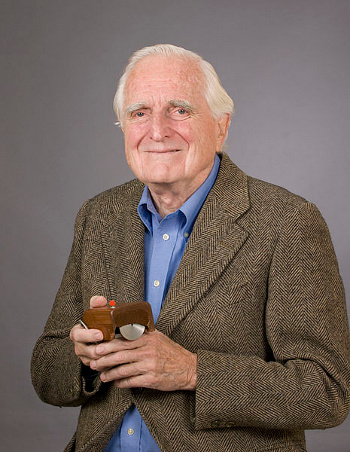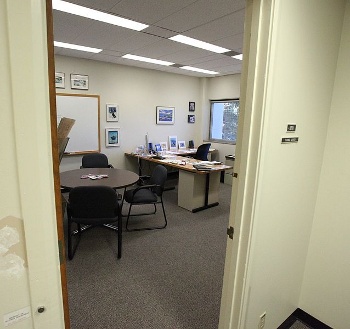Douglas C. Engelbart
July 5, 2013
I have a
confession. I was once anti-
mouse. In the early
1980s, very early in
personal computer history, I was doing extensive
word processing with one of the popular word-processing programs of the time,
WordStar. To show how early this was in a personal computer sense, my
computer was a
CP/M computer I had built myself. In the WordStar program, as in all others of the time, the author would move around the text using key strokes.
The easy key strokes, of course, were the
vertical and horizontal tabs (the arrow keys). There were other commands, if you could remember them, for moving from word to word, moving page-wise, etc.. A few years later, personal computing started to become popular, and companies, such as
Logitech, found a way to use the
serial port and a simple interface program as a mouse interface for many such programs.
I had never seen such mice in action, so I stuck to my keyboard for many years. After a while, I saw the mouse advantage, and now I prefer a mouse over a
trackpad or
touchscreen. In fact, I
hate trackpads and touchscreens, possibly because I have fat fingers. The
inventor of the
computer mouse,
Douglas C. Engelbart, died on July 2, 2013, at age 88.[1-7]

Douglas Engelbart (January 30, 1925 - July 2, 2013)
This 2008 photograph shows Engelbart holding the first computer mouse prototype, which had a wooden shell.
The "mouse" name evolved because of its size and the long, tail-like wire.
(SRI International photograph, via Wikimedia Commons.)
Engelbart's death was first announced in a message sent by his daughter, Christina, on the
email reflector of the
Computer History Museum, where Engelbart was a
fellow.[2, 3] Christina, who was also his
biographer, said her father had been in recent poor health and died peacefully in his sleep at his home in
Atherton, California.[2-4] His wife, Karen O'Leary Engelbart, later said that the cause was
kidney failure.[5]
Douglas C. Engelbart was born on January 30, 1925, on a small farm outside
Portland, Oregon, to a
father who was a
radio repairman and a
housewife mother.[2-4] Some sources quote his birthdate as January 25, 1925.[5,7] He graduated from
high school in 1942, attended
Oregon State College, where he studied
electrical engineering, and was
drafted near the end of
World War II.[2,5] Engelbart served two years in the
US Navy as a
radar technician in the
Philippines.[3-5] It was there, in a
Red Cross library, that he had a formative moment.[4-5,7]
In that Red Cross library, he read the July, 1945, "
As We May Think" essay by
Vannevar Bush in
The Atlantic Monthly. In that essay, Bush proposed a computer memory aid he called
Memex.[4-5,7] This system would have functioned much like the
hyperlinks to
Wikipedia that I include in my articles. I wrote about Vannevar Bush in an
earlier article (Basic Research, October 22, 2010).
After the war, Engelbart joined the
National Advisory Committee for Aeronautics, predecessor to
NASA, as an
electrical engineer at its
Ames Laboratory.[2-5,7] He left Ames in 1951 to work on his
Ph.D. in
electrical engineering at the
University of California, Berkeley.[2-4,7]. Engelbart finished his degree in 1955 and joined the Berkeley faculty, but his futuristic ideas did not mesh with an
assistant professor's responsibilities, so he left for the
Stanford Research Institute.[3-4]
The Stanford Research Institute, which was founded by Stanford University to do contract
R&D, is now known as
SRI International.[3-4] SRI was funded by the
defense department's Advanced Research Projects Agency, as well as NASA and the
Air Force.[1,6] At SRI, Engelbart founded his own computer
laboratory, called the Augmentation Research Center.[2] Engelbart's laboratory helped the development of
ARPANET, predecessor to the
Internet.[2]
The idea of the mouse came from an early 1960s contract from NASA to Engelbart's Augmentation Research Center for the development of better ways to select items on a
computer screen.[1]
Light pens, which I had once used, don't work well, nor do
joysticks. One device Engelbart considered was an under-table device operated by a
knee.[2] The mouse concept came to Engelbart while he was attending a
computer graphics conference in 1964.[5] Engelbart sketched his device concept, which was prototyped by William English, a
mechanical engineer at SRI, as a mechanism inside a small
pine wood box.[1-3,5]

Figures two and three from US Patent No. 3,541,541, 'X-Y Position Indicator for a Display System,' by Douglas C. Engelbart, November 17, 1970.
This patent is referenced by 121 other patents and patent applications.
(Via Google Patents.)[8)]
This was an idea before its time. The only money made from the mouse was a $40,000
licensing fee from
Apple to SRI in 1983.[2] The mouse
patent expired in 1987, before the mouse had widespread use, although at least a billion mice have been sold to date.[2-4] Fortunately, Engelbart did make some money for himself on other patents, and speaking engagements after his fame.[7]
The mouse was first demonstrated at the 1968 Fall
Joint Computer Conference in
San Francisco.[1-2]. Engelbart demonstrated not just the mouse, but
hyperlinks, separate applications running in their own
windows, live text editing and interactive computing.[1,5,7] This ninety-minute presentation was subsequently called "
the mother of all demos."[1-3,5-6,9]
Alan Kay was in the audience that day. Kay subsequently joined
Xerox PARC and implemented these features into
SmallTalk.[6] From Xerox PARC, these ideas migrated to Apple.[5]
Engelbart apologized for the "mouse" name during his presentation, saying
"I don't know why we call it a mouse – sometimes I apologize for it. It started that way and we never did change it."[3]
It's been reported that Engelbart's ideas were so advanced that his
management didn't understand them.[6] Engelbart's ideas were incorporated into an SRI computer system,
Augment NLS, short for "oN Line System," which became the first of two nodes of ARPAnet, the other being at
UCLA.[5-6] Engelbart's SRI group once numbered at more than fifty, but it was disbanded in the 1970s, with the NLS system being sold to
Tymshare.[5]

One thing that Doug Engelbart and I had in common was the same office carpeting.
This is an undated photograph of his SRI office. The large, flat-screen display indicates it must be the late 1990s or after.
(Photo by Robert Scoble, via Wikimedia Commons.)
Engelbart believed that computing enabled small research teams to amplify their "collective IQ," a process he called bootstrapping.[5] He started the
Bootstrap Institute in 1990.[3] People started to realize in the 1990s all the things that Engelbart had done, and that's when the awards started rolling in. Engelbart was awarded the
Turing Award, the 2000 US
National Medal of Technology, the
Lovelace Medal, the 1997
Lemelson-MIT Prize (worth a half-million dollars), and
Yale's first honorary doctorate of engineering and technology.[1,3-4,7]. He had been a fellow of the Computer History Museum since 2005.[2]
Engelbart was quick to acknowledge the contributions of his collaborators.[4] As he said in the biography authored by his daughter,
"Many of those firsts came right out of the staff's innovations - even had to be explained to me before I could understand them. They deserve more recognition."[3-4]
Curtis R. Carlson,
president and
CEO of SRI, is quoted by Stanford University as saying,
"Doug was a giant who made the world a much better place and who deeply touched those of us who knew him... We will miss his genius, warmth and charm. Doug's legacy is immense – anyone in the world who uses a mouse or enjoys the productive benefits of a personal computer is indebted to him."[1]
References:
- Brooke Donald, "Stanford researcher Doug Engelbart, inventor of the computer mouse, dies, Stanford Report, July 3, 2013.
- Computer mouse inventor Doug Engelbart dies at 88, BBC News, July 3, 2013.
- Olivia Goldhill, "Doug Engelbart, inventor of the computer mouse, dies at 88," Telegraph (UK), July 3, 2013.
- Doug Engelbart, inventor of computer mouse, dies at 88, Guardian (UK), July 3, 2013.
- John Markoff, "Douglas C. Engelbart, 1925-2013," The New York Times, July 3, 2013.
- Cade Metz, "Doug Engelbart, Who Foresaw the Modern Computer, Dies at 88," Wired, July 3, 2013.
- Iain Thomson, "Douglas Engelbart, PC pioneer and creator of the mouse, dies at 88," The Register (UK), July 3, 2013.
- Douglas C. Engelbart, "X-Y Position Indicator for a Display System," US Patent No. 3,541,541, November 17, 1970.
- Douglas Engelbart : The Mother of All Demos, December 9, 1968, YouTube video.
Permanent Link to this article
Linked Keywords: Confession; mouse; 1980s; history of personal computers; word processor; word processing; WordStar; S-100 bus computer; CP/M computer; vertical and horizontal tabs; Logitech; serial port; trackpad; touchscreen; inventor; computer mouse; Douglas C. Engelbart; prototype; wooden; tail; wire; SRI International; Wikimedia Commons; electronic mailing list; email reflector; Computer History Museum; fellow; biography; biographer; Atherton, California; renal failure; kidney failure; Portland, Oregon; father; radio; repairman; housewife; mother; high school; Oregon State College; electrical engineering; conscription; draft; World War II; United States Navy; radar; technician; Philippines; Red Cross; library; As We May Think; Vannevar Bush; The Atlantic Monthly; Memex; hyperlink; Wikipedia; National Advisory Committee for Aeronautics; NASA; electrical engineer; Ames Laboratory; Doctor of Philosophy; Ph.D.; University of California, Berkeley; assistant professor; Stanford Research Institute; Research and development; R&D; SRI International; United States Department of Defense; Advanced Research Projects Agency; United States Air Force; laboratory; ARPANET; Internet; computer monitor; computer screen; light pen; joystick; knee; computer graphics; academic conference; mechanical engineer; pine wood; Google Patents; license; Apple Inc.; patent; Joint Computer Conference; San Francisco; hyperlinks; >window; the mother of all demos; Alan Kay; Xerox PARC; SmallTalk; management; Augment NLS; University of California, Los Angeles; UCLA; Tymshare; carpeting; The Doug Engelbart Institute; Bootstrap Institute; Turing Award; National Medal of Technology; Lovelace Medal; Lemelson-MIT Prize; Yale University; Curtis R. Carlson; president; chief executive officer; CEO.